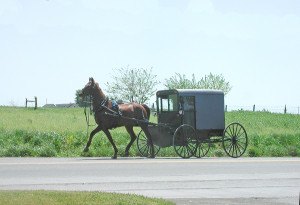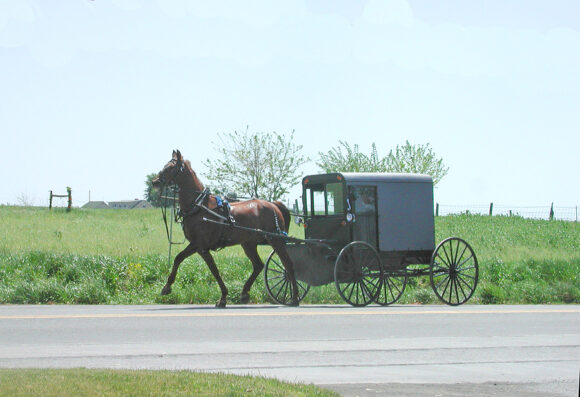Nothing says “Lancaster County” like the sight and sound of a lathered horse pulling a square, black buggy down the road.
The county undoubtedly has more of the horse-powered vehicles than any other in Pennsylvania, based on population data.
And while that means Lancaster County is the place to go to witness Plain Sect life, it also means emergency responders here have to pick up the pieces from more buggy crashes than any other county in the state.
A lot more.
But the annual number of crashes here actually has gone down over the past decade or so, thanks to better lighting, more education and efforts by the state transportation department.
“From our personal experiences as a shop, and the crashes we’ve seen coming in, we actually think we’ve seen a decrease the last couple of years,” said a member of the Pennsylvania Amish Safety Committee, who builds buggies in Upper Leacock Township, and asked not to be named.
According to Pennsylvania Department of Transportation accident data, there were 282 wrecks involving horse-drawn buggies in Lancaster County from 2004 through February 2013.
(There have been another 20 since then.)
For the 2004-2013 period, Mifflin County ranked second with 37 horse-and-buggy crashes.
“It’s really not that surprising that we have so many more,” said Salisbury Township Supervisor Les Houck.
“We have more Amish than anyone else, and we have a lot of traffic.”
Also not surprising, the most buggy wrecks here occurred in municipalities with some of the highest Amish populations and some of the busiest roads.
Salisbury Township was tops with 28 wrecks, followed by Leacock Township with 27, East Lampeter Township with 25 and Paradise Township with 24.
Routes 340, 30, 897 and 741 often were places where vehicles and buggies collided in these municipalities.
“A lot of it has to do with the sheer volume of traffic,” said John Bowman, chief of East Lampeter police. “These are busy roads anyway, and then you add buggies to the mix and accidents are going to occur.”
Yet even as the county’s total population has grown, and the roads have gotten busier, the number of buggy crashes here annually has decreased.
From 2000-2010, census figures show the county’s population grew 10 percent from 470,658 to 519,445.
The Amish population here grew 50 percent, from just over 20,000 in 2000 to about 31,000 in 2012, according to figures compiled by the Young Center for Anabaptist and Pietist Studies at Elizabethtown College.
(Old Order Mennonites sometimes drive horse-drawn buggies as well, but there are no figures on their population.)
For PennDOT’s 2004-2013 data period, the annual number of buggy crashes trended down from a high of 34 in 2004 to a low of 23 in 2012.
(The 2013 total of 14 wrecks does not reflect a full year’s worth of crash data. PennDOT only had a partial year’s worth.)
Lancaster County is divided into five districts by the Amish Safety Committee.
The committee, which is made up of Amish church members from each area, travels across the county every summer to discuss safety issues of all types.
And local Amish residents show up for the meetings in droves.
“We cover everything from farm safety to OSHA to driving buggies,” the committee member said.
In recent years, the committee has spent a considerable amount of time at each safety meeting on buggy driving.
“A lot of what we stress is courtesy, respect, common sense – but we also touch on lighting, horse handling, cowboying on the road, keeping your body parts inside the buggy,” the committee member said.
He named improved lighting as a chief reason buggy crashes have gone down here in recent years.
“We’ve made some serious changes with our lighting systems, using LED lights and more lighting,” he said.
“The LEDs are more intense and they use less juice from the battery.”
An issue every buggy driver will deal with at some time, the man said, is driving at night with a dead battery.
“We all experience it,” he said.
There’s no question driving a black buggy without lights in the dark is dangerous.
“LEDs use so little juice, that you can turn off the headlights and run rear, four-way flashers on a dead battery for hours,” the man said.
“It’s not a good idea to drive with your headlights off, but having four-way flashers is better than nothing.”
Buggy makers also have been promoting more use of reflective tape.
“The reflective material really glows,” he said.
PennDOT too has been helping with buggy-safety issues.
Paradise Township Supervisor Dennis Groff, who also is the township’s emergency management coordinator and roadmaster, said that when the state installed a traffic light at the intersection of Route 741 and Belmont Road last year, it greatly improved “one of the deadliest intersections in the state.”
There was no available data specific to that intersection.
And when the intersection of Routes 372 and 222 at Buck was realigned in 2007, video cameras in the traffic signals were designed to detect buggies on the shoulder, so the lights change colors when a buggy approaches.
Looking ahead, PennDOT has a project in the works to widen Route 896 from Strasburg to Route 30 – including the bridge over Pequea Creek – so that buggies will have a full travel lane on the shoulder.
“We certainly take buggy traffic into consideration when we do road projects in Lancaster County,” said PennDOT spokesman Greg Penny.
Such projects are great Groff said, but they don’t address what he sees as the number-one cause of wrecks involving buggies.
“People drive way too fast on our roads,” he said. “Nobody’s patient anymore.
“People have to be willing to slow down, because when there’s an accident, buggies are no match for cars.”
Was this article valuable?
Here are more articles you may enjoy.


 Losses Top $20 Billion in Asia Floods as Climate Risks Grow
Losses Top $20 Billion in Asia Floods as Climate Risks Grow  California Again Delays Wildfire Protection Rules for Homes
California Again Delays Wildfire Protection Rules for Homes  ‘Super Roofs’ Are Rewarding Insurers, Cat Bond Investors and Homeowners
‘Super Roofs’ Are Rewarding Insurers, Cat Bond Investors and Homeowners  OpenAI And Microsoft Sued Over Murder-Suicide Blamed on ChatGPT
OpenAI And Microsoft Sued Over Murder-Suicide Blamed on ChatGPT 